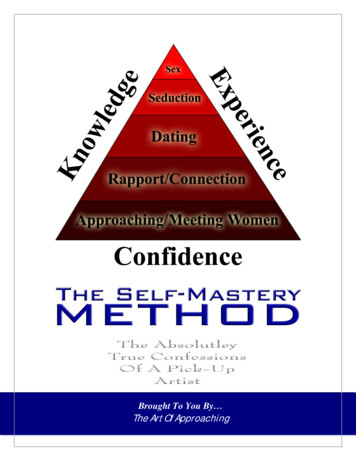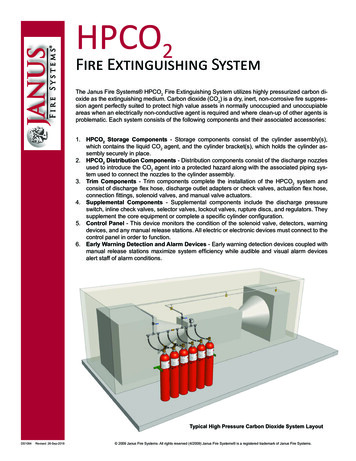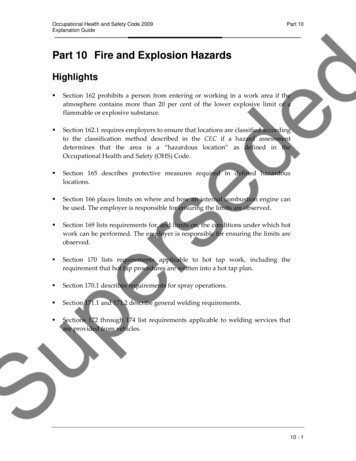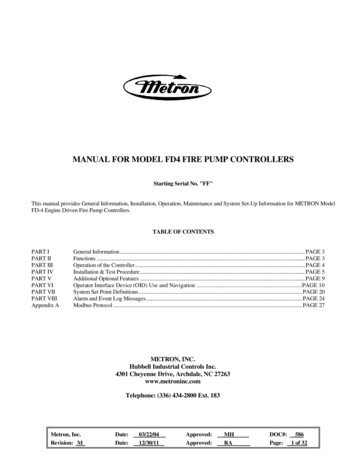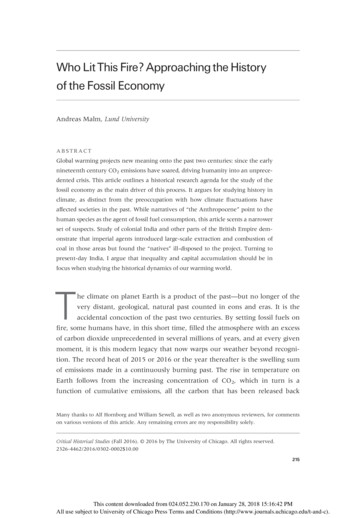
Transcription
Who Lit This Fire? Approaching the Historyof the Fossil EconomyAndreas Malm, Lund UniversityAB ST RACTGlobal warming projects new meaning onto the past two centuries: since the earlynineteenth century CO2 emissions have soared, driving humanity into an unprecedented crisis. This article outlines a historical research agenda for the study of thefossil economy as the main driver of this process. It argues for studying history inclimate, as distinct from the preoccupation with how climate fluctuations haveaffected societies in the past. While narratives of “the Anthropocene” point to thehuman species as the agent of fossil fuel consumption, this article scents a narrowerset of suspects. Study of colonial India and other parts of the British Empire demonstrate that imperial agents introduced large-scale extraction and combustion ofcoal in those areas but found the “natives” ill-disposed to the project. Turning topresent-day India, I argue that inequality and capital accumulation should be infocus when studying the historical dynamics of our warming world.The climate on planet Earth is a product of the past—but no longer of thevery distant, geological, natural past counted in eons and eras. It is theaccidental concoction of the past two centuries. By setting fossil fuels onfire, some humans have, in this short time, filled the atmosphere with an excessof carbon dioxide unprecedented in several millions of years, and at every givenmoment, it is this modern legacy that now warps our weather beyond recognition. The record heat of 2015 or 2016 or the year thereafter is the swelling sumof emissions made in a continuously burning past. The rise in temperature onEarth follows from the increasing concentration of CO2, which in turn is afunction of cumulative emissions, all the carbon that has been released backMany thanks to Alf Hornborg and William Sewell, as well as two anonymous reviewers, for commentson various versions of this article. Any remaining errors are my responsibility solely.Critical Historical Studies (Fall 2016). 2016 by The University of Chicago. All rights reserved.2326-4462/2016/0302-0002 10.00215This content downloaded from 024.052.230.170 on January 28, 2018 15:16:42 PMAll use subject to University of Chicago Press Terms and Conditions (http://www.journals.uchicago.edu/t-and-c).
216 CRIT ICAL H IST ORIC AL STU DIE SFALL 2016into the atmosphere, from which it was tucked away underground for hundredsof millions of years: surely the most fateful fire ever started.1One could, it follows, argue that outside of hard climate science, historyshould be the preeminent field for the study of global warming. Or, all researchinto the process should be inflected by historical consciousness—and to someextent it already is, since the object of inquiry is by definition one of change overtime. In The History Manifesto, Jo Guldi and David Armitage point out that climatescientists “have unknowingly become historians” merely by asserting humanorigination; as their science progresses, and as the opportunities for averting trulycatastrophic climate change recede by the day, they shuttle between past andfuture via a present that frays into both.2 Change over time—the special expertise of the history discipline—is the order of the day, as the past two centuriessweep us up from behind like a landslide and push us toward a future of potentially insufferable conditions on Earth. Such is the gist of the message from thousands and thousands of climate scientists. But, one might ask: have historians responded to them?This article outlines an agenda for research into the history of our changingclimate. It begins by distinguishing this pursuit from a more established field ofstudy: the impacts of climatic fluctuations on past societies. Some reasons forprobing deeper into the history of climate are adduced, most of them boilingdown to a simple question: who lit and spread this epochal fire? We hone in onthe fossil economy as the general driver of climate change and then considersome actual cases from the annals of the British Empire, whose projection ofsteam power onto India and other colonies proved crucial to the diffusion of thatpeculiar kind of economy. We then return to some conceptual issues of historicalresponsibility and causality. “The Anthropocene,” now the generally acceptedmaster concept for the study of climate change, identifies a universal speciesagent as the force behind the fire; a similar tendency inheres in the commonargument that the Soviet Union and its satellite states were among the worstoffenders ever. Against these expansive attributions of blame, the agendasketched here is narrowed down at the top and illustrated, finally, with a returnto the coal fires now rapidly expanding in India.1. For some more extensive reflections on this historicity and temporality of climate change, seeAndreas Malm, Fossil Capital: The Rise of Steam Power and the Roots of Global Warming (London: Verso, 2016).2. Jo Guldi and David Armitage, The History Manifesto (Cambridge: Cambridge University Press,2014), 33. Climate change remains a key point of reference throughout the manifesto.This content downloaded from 024.052.230.170 on January 28, 2018 15:16:42 PMAll use subject to University of Chicago Press Terms and Conditions (http://www.journals.uchicago.edu/t-and-c).
Approaching the History of the Fossil Economy 217F R O M CLI M A T E - I N - H I S T O R Y T O H IS T O RY - I N - C L IM A T ESo far, anthropogenic global warming has principally inspired research into theeffect of nonanthropogenic global cooling on past societies. As a monument towhat this kind of scholarship can achieve stands Geoffrey Parker’s Global Crisis:War, Climate Change, and Catastrophe in the Seventeenth Century, an Olympian chronicle of how the Little Ice Age brought extreme chills, droughts, downpours, andother anomalies to the four corners of the world, thereby contributing—not asthe sole cause, as Parker is at pains to emphasize, but as a spark or aggravatingcircumstance, and as the common global denominator—to famine, riot, plunder,rape, pogrom, regicide, civil war, dynastic war, religious war, and an endlesscatalog of other miseries from China to Sweden. A third of the human populationmight have perished in the bitter mayhem.3 In another work in the same genre,The Climate of Rebellion in the Early Modern Ottoman Empire, which possibly lives upto its claim of being “the most detailed analysis of a major climate crisis yet,” SamWhite zooms in on how the Little Ice Age played out in Anatolia and the Levant:while suffering from unprecedented drought and dearth, peasants were orderedto feed the war machine of the imperial state with ever-growing taxes.4 Thecombination tipped them over the edge and into uprisings against tax collectors,unrestrained banditry, popular armies that rampaged through the countrysidewhile adverse weather—caused by natural fluctuations in solar output and volcanic activity—continued to sap the foundations for agriculture. Previous scholarsof the seventeenth-century Ottoman chaos have searched for explanations amongrulers and subjects, without as much as looking at the climate in which they lived,but “sensitized as we are today” to the factor, such neglect appears astounding. “Ina world now facing global warming, the significance of climate change on humanaffairs should be readily apparent.”5This is the first historiographical revolution in a warming world: the study ofclimate in history.6 It has been immensely facilitated by the work of climatescientists, who have handed over to historians whole archives of data—ice cores,tree rings, pollen and spores deposited in lakes—that tell previously unknownstories about when and where extreme weather events struck; these archives can3. Geoffrey Parker, Global Crisis: War, Climate Change, and Catastrophe in the Seventeenth Century (NewHaven, CT: Yale University Press, 2013).4. Sam White, The Climate of Rebellion in the Early Modern Ottoman Empire (Cambridge: CambridgeUniversity Press, 2011), 14.5. Ibid., 137, 298.6. For a smorgasbord of approaches, see the forum in Environmental History 19, no. 2 (2014).This content downloaded from 024.052.230.170 on January 28, 2018 15:16:42 PMAll use subject to University of Chicago Press Terms and Conditions (http://www.journals.uchicago.edu/t-and-c).
218 CRIT ICAL H IST ORICAL STUDIE SFALL 2016then be juxtaposed to letters and diaries, ships’ logs and paintings and othersources historians are used to working with. Current warming can light up pastevents we thought we knew inside out. Spurred by the insight that this doesindeed change everything, and with the newly opened archives, some aim toreconstruct the whole arc of human history as a long dance with the ups-anddowns of climate, from the settling of the Nile Delta via the decline of the RomanEmpire to the Enlightenment and onward.7Such history has its pitfalls and limitations. One is the old specter of climatedeterminism. In an essay in Proceedings of the National Academy of Sciences, sevenresearchers correlate variations in temperature with “periods of harmony andcrisis” in the northern hemisphere before 1800, throwing into their models suchvariables as population size, nutritional status, migration, epidemics, and war,concluding that “climate change was the ultimate cause of human crisis in preindustrial societies.”8 But that is written by a team of geographers; neither Parker nor White can be accused of toying with monocausal explanations—to thecontrary, their works trace the impacts of climate change as differentially articulated through the social relations of the seventeenth century. Here the problem isanother.Parker, for one, is interested in how humans can learn to adapt to hostileclimate and “prepare for long-term recovery” after a disaster.9 His study is a sobering lesson in all that can go wrong when the climatic rug is pulled from undercivilization; framed by reflections on the extreme weather of today, it counsels usto adjust wisely. But what if adaptation to—let alone long-term recovery in—aworld of, say, more than 2 C is plainly impossible, particularly for the vast majority of the human population that resides outside of centers of comforting affluence? Then other lessons might be in greater demand. Moreover, some ofParker’s comments can be read as suggesting that catastrophic global warming isdestined to happen, itself beyond the remit of historical research: “The criticalissues are not whether climate change occurs, but when; and whether it makesbetter sense for states and societies to invest money now to prepare for naturaldisasters that are inevitable—hurricanes in the Gulf and Atlantic coasts of NorthAmerica; storm surges in the lands around the North Sea; droughts in Africa;7. See, e.g., Wolfgang Behringer, A Cultural History of Climate (Cambridge: Polity, 2010).8. David D. Zhang, Harry F. Lee, Cong Wang, et al., “The Causality Analysis of Climate Change andLarge-Scale Human Crisis,” PNAS 108, no. 42 (2011): 17301.9. Parker, Global Crisis, 693.This content downloaded from 024.052.230.170 on January 28, 2018 15:16:42 PMAll use subject to University of Chicago Press Terms and Conditions (http://www.journals.uchicago.edu/t-and-c).
Approaching the History of the Fossil Economy 219prolonged heat waves—or instead wait to pay the far higher costs of inaction—inaction, that is, in the sphere of adaptation, not mitigation.”10But this is to abdicate from the central task of historians in a warming world.That should be to study history in climate. Many reasons could be adduced forthe pursuit; four immediately strike the eye. First, since we know that there wasnever anything inevitable about this fire—it was created, not deliberately butactively, by human beings over the past two centuries: this is the alfa and omegaof the science—and since the scenario of continued business-as-usual must bedeemed intolerable, pushing us toward considering all means necessary forejecting fossil fuels from the world economy, we would want to know whatsocial forces introduced and expanded their consumption.11 It could make thestruggle against them easier. Second, the history of global warming is also thehistory of alternatives to spiraling combustion discarded along the way. Knowingabout these might help in the search for exit strategies.12Third, and perhaps most strangely overlooked, climate politics has beenbogged down in a debate over historical responsibility: rarely have issues of thepast proved so divisive for so long in so highly profiled international negotiations.The United Nations Framework Convention on Climate Change (UNFCCC) famously enshrines the principle of “common but differentiated responsibility”—meaning that some countries have done more than others to create the problem—but what exactly this implies and how it should be translated into obligations forcutting emissions, or financing adaptation, or compensating the victims, havebeen bones of interminable contention. Values of justice are at stake here. Sincea few rich countries account for the bulk of cumulative emissions, should theynot shoulder a proportionate burden for cleaning up the mess? Surely all humanbeings have the same right to use the atmosphere as a sink for CO2, but somehave obviously used up far more than their fair share—so have they not accumulated a debt to those who have consumed less or nothing at all? If so, should theynot cut their emissions so dramatically as to turn them negative, while others are10. Ibid., xxxii; cf. 689–96. For a similar focus on adaptation in other agendas for climate history, seeGeorgina H. Endfield, “Exploring Particularity: Vulnerability, Resilience, and Memory in Climate ChangeDiscourses,” 309; Lawrence Culver, “Seeing Climate through Culture,” 316; and Sherry Johnson, “WhenGood Climates Go Bad: Pivot Phases, Extreme Events, and the Opportunities for Climate History,” 334, allin Environmental History 19, no. 2 (2014).11. One attempt along these lines is Malm, Fossil Capital.12. As stressed by Guldi and Armitage, History Manifesto, 30–31, 35, 68–69. A most fascinatingepisode is recovered in Vicky Albritton and Fredrik Albritton Jonsson, Green Victorians: The Simple Lifein John Ruskin’s Lake District (Chicago: University of Chicago Press, 2016).This content downloaded from 024.052.230.170 on January 28, 2018 15:16:42 PMAll use subject to University of Chicago Press Terms and Conditions (http://www.journals.uchicago.edu/t-and-c).
220 CRIT ICAL HIS TORI CAL ST UDI ESFALL 2016allowed to emit a bit more, and bankroll the necessary adaptation and pay for theunavoidable loss and damage they have inflicted on the blameless poor? Or is itthe other way around: perhaps these pioneers did a service to the rest of humanityby initiating the rapid development that fossil fuels alone made possible? Shouldnot the latecomers, then, rather be grateful for the living standards to which theyhave been invited?13While policy makers, activists, and moral philosophers continue to wrangleand ruminate over these issues and others no less thorny, natural scientistshave come up with raw numbers. We know, for instance, that the Organizationfor Economic Cooperation and Development (OECD) countries put up 86 of the107 parts per million by which the CO2 concentration rose from 1850 to2006.14 As of the year 2000, the advanced capitalist countries of the North held16.6 percent of the world population but were responsible for 77.1 percent ofthe CO2 pumped out since 1850; the share of the United States alone stood at27.6 percent, while Nigeria had a paltry 0.2 percent, Turkey 0.5 percent, Indonesia 0.6 percent, Brazil 0.9 percent—these being countries with a historicalresponsibility sufficiently large to make it on a top-20 list. Most left even smallermarks.15 Counting only from 1990, by far the largest debts have been accumulated by the United States, followed by Russia, Canada, Germany, and the UnitedKingdom, while the biggest creditors—that is, countries with large populationsemitting less than their per capita shares—were, on top, India, then China,Bangladesh, Pakistan, and Nigeria.16 Sixty-three percent of the cumulative emis-13. For some contributions to the debate, see Tom Athanasiou and Paul Baer, Dead Heat: GlobalJustice and Global Warming (New York: Seven Stories Press, 2002); Andrew Simms, Ecological Debt: TheHealth of the Planet and the Wealth of Nations (London: Pluto, 2005); J. Timmons Roberts and Bradley C.Parks, A Climate of Injustice: Global Inequality, North-South Politics, and Climate Policy (Cambridge, MA: MITPress, 2007); Steve Vanderheiden, Atmospheric Justice: A Political Theory of Climate Change (New York: Oxford University Press, 2008); Eric Neumayer, “In Defence of Historical Accountability for GreenhouseGas Emissions,” Ecological Economics 33, no. 2 (2000): 185–92; Simon Caney, “Justice and the Distribution of Greenhouse Gas Emissions,” Journal of Global Ethics 5, no. 2 (2009): 125–46; Christian Baatz,“Responsibility for the Past? Some Thoughts on Compensating Those Vulnerable to Climate Change inDeveloping Countries,” Ethics, Policy and Environment 16, no. 1 (2013): 94–110; Rikard Warlenius, Gregory Pierce, and Vasna Ramasar, “Reversing the Arrow of Arrears: The Concept of ‘Ecological Debt’ andIts Value for Environmental Justice,” Global Environmental Change 30 (2015): 21–30.14. P. Ciais, T. Gasser, J. D. Paris, et al., “Attributing the Increase in Atmospheric CO2 to Emitters andAbsorbers,” Nature Climate Change 3 (2013): 926–30.15. Michel G. J. den Elzen, Jos G. J. Olivier, Niklas Höhne, and Greet Janssens-Maenhout, “Countries’Contribution to Climate Change: Effect of Accounting for All Greenhouse Gases, Recent Trends, BasicNeeds and Technological Progress,” Climatic Change 121, no. 2 (2013): 397–412.16. H. Damon Matthews, “Quantifying Historical Carbon and Climate Debts among Nations,” NatureClimate Change (2015): 1–6, nt/full/nclimate2774.html.This content downloaded from 024.052.230.170 on January 28, 2018 15:16:42 PMAll use subject to University of Chicago Press Terms and Conditions (http://www.journals.uchicago.edu/t-and-c).
Approaching the History of the Fossil Economy 221sions between 1751 and 2010 can be traced to 90 corporations in the business ofextracting fossil fuels.17As useful as these figures are, and as much as one would wish to see more ofthem—notably on the responsibilities and debts of classes—they can comeacross as somewhat stylized and anemic.18 They do not convey the dynamics ofthe history in question. No numbers can capture its texture, lay bare processesof causation, specify who did what for what reasons and in the service of whomto set the world on the path to this blaze: only historical narrative and analysiscould accomplish that. And yet historians have been conspicuous by their absence from the debate.Fourth, even if there were to be no meaningful mitigation, no exit, no comprehensive international agreement effectively implemented—no measures, inshort, to reign in business as usual—there presumably would still be some interest in the question of how humanity ended up on an unlivable planet. The first,third, and fourth of these reasons could be somewhat crudely summed up: wholit and spread the fire of the fossil economy from the time of the IndustrialRevolution up to the present—why, where, and how?We are dealing with a historicized climate, a biosphere that carries the imprint of what some have done in the past, and it is their momentous course ofaction that needs to be retraced. Such a move from climate-in-history to historyin-climate, toward a second historiographical revolution, would lead to anothermethodological imperative, taking data on empires and industries to temperatures and precipitation, rather than the other way around. In the OttomanEmpire, to stick with that case, this could mean an investigation into how itslands were subsumed under an economy that grew by burning coal; here thecrucial events would be not the Celali rebellion or the lynching of Ahmed Pashabut the Balta Liman treaty of 1838, the British-Egyptian war of 1840, the Crimean War, the European loans; not the outbreak of drought but the arrival ofthe steam engine. Not the seventeenth century but the nineteenth and its successor century would be in focus.19 In a world facing global warming, the signifi-17. Richard Heede, “Tracing Anthropogenic Carbon Dioxide and Methane Emissions to Fossil Fueland Cement Producers, 1854–2010,” Climatic Change 122, no. 1 (2014): 229–41.18. A more qualitative historical approach, targeting fossil fuel corporations for their sabotage ofclimate change mitigation, is on offer in Peter C. Frumhoff, Richard Heede, and Naomi Oreskes, “TheClimate Responsibility of Industrial Carbon Producers,” Climatic Change 132, no. 2 (2015): 157–71.19. Needless to say, the explosion of fossil fuel combustion in the nineteenth century had its rootsin previous epochs that also need to be traced. For some reasons to date the qualitative leap to thiscentury, see Malm, Fossil Capital.This content downloaded from 024.052.230.170 on January 28, 2018 15:16:42 PMAll use subject to University of Chicago Press Terms and Conditions (http://www.journals.uchicago.edu/t-and-c).
222 CRI TICAL HI STORI CAL ST UDIESFALL 2016cance of how fossil fuels first came to be combusted on a large scale, and howthis habit spread unevenly across the world, should be readily apparent.T HE FOS S I L E CONOMY AS OBJECT O F S T UDYThe spiral of climate change is set in motion by the act of identifying, diggingup, and setting fire to fossil fuels: this is the axis around which the process revolves. Put differently, the fundamental historical fact of global warming is thecommencement of large-scale consumption of those fuels, something truly newunder the sun. For most of human history, the deposits were left untouched,safely locked out from the active carbon cycle. Then a qualitatively novel type ofeconomy irrupted into them. We shall call it the “fossil economy,” most simplydefined as one of self-sustaining growth predicated on the growing consumptionof fossil fuels and therefore generating a sustained growth in CO2 emissions.20 Itis flanked by other processes (notably deforestation) and other greenhouse gases(methane, nitrous oxide, sulfur hexafluoride, etc.), but there can be little doubtabout its principal culpability.Once the fireplaces were built, they were augmented and reinforced, stoneupon stone; no less than the altered atmospheric composition as such, it is thisearthly legacy that constrains the present and future. In its latest report, theIntergovernmental Panel on Climate Change (IPCC) warns about “the tendencyfor past decisions and events to self-reinforce, thereby diminishing and possibly excluding the prospects for alternatives to emerge.”21 Once a highway or a coalfired power plant is built, it is meant to last for many decades; there are profits tobe reaped from long usage; consumers become accustomed to the convenience;planning, advertisement, trade, subsidies, and investment conspire to lock in theinfrastructure and, rather than shelve it, enlarge it further. Alternatives tend tobe closed off, the power of the past to grow, emissions to spur emissions.22If it emerged in the early nineteenth century, the fossil economy has sincespiraled on unabated. But the disclosure of its real import is of a recent date and,as a quick glance at any journal of climate science will make clear, still very muchunfinished: “One might say that this development,” to amend Walter Benjamin,20. See further, ibid.21. O. Edenhofer, R. Pichs-Madruga, Y. Sokona, et al., Climate Change 2014: Mitigation of Climate Change:Contribution of Working Group III to the Fifth Assessment Report of the Intergovernmental Panel on Climate Change(Cambridge: Cambridge University Press, 2014), 312; emphasis added.22. See, e.g., Peter Erickson, Sivan Kartha, Michael Lazarus, and Kevin Tempest, “Assessing Carbon Lock-In,” Environmental Research Letters 10 (2015): 084023.This content downloaded from 024.052.230.170 on January 28, 2018 15:16:42 PMAll use subject to University of Chicago Press Terms and Conditions (http://www.journals.uchicago.edu/t-and-c).
Approaching the History of the Fossil Economy 223“occurred behind the back of the last two centuries, which were not yet aware of thedestructive energies of technology.”23 When natural scientists reveal one unexpected effect after another, they write out an ever-lengthening request to historians for research—or, to borrow another metaphor from Benjamin: historicalknowledge should take the shape of balanced scales, one tray weighted with thepast and the other with the present (and the future). On the second tray, there isnow the ponderous fact of global warming. On the first, the facts—and they “cannever be too humble or too numerous”—remain to be assembled in anything likea matching weight.24We might have thought that the past two centuries were fairly well covered,but if what may well be their most devastating consequences played out behindtheir backs, in abeyance, we need to revisit this past with them in mind.25 Anevent like the carving up of the Ottoman Empire into Western zones of dominance, where oil was discovered and drilled, can now be flipped over, its atmospheric face upward—not merely because CO2 from that very oil makes up atranche of the cumulative emissions changing the climate of today (and tomorrow) but also because that event consolidated the fossil economy. The exploitation of Middle Eastern oil locked in CO2-intensive infrastructure on unprecedented scales, from the Bay Area to the Gulf, increasing the weight of thispeculiar economy by orders of magnitude. Only the history of that totality can bewritten. No single impact, no one heat wave or extinct species can be causallylinked to the burning of a specific barrel of oil or cubic feet of gas, for everymolecule of CO2 mixes in the air and acts upon the earth together with everyother, in the aggregate. The events of the past two centuries are of interest asmoments in the development—in all its dimensions, including political, ideological, cultural—of the fossil economy as a whole.To get closer to it, we need to dip at least a toe in the annals of that totality.Here the choice has fallen on some episodes from the British Empire, beginningwith the nation to which the over-emitters seem to owe their greatest debt: India.C OA L C O M E S T O I N D I AIn the second quarter of the nineteenth century, following the occupation ofAssam in 1825, the British Empire resolved to fill the rivers of India with steam-23. Walter Benjamin, Selected Writings: Volume 3, 1935–1938 (Cambridge, MA: Harvard UniversityPress, 267). The original has “the last century, which was not yet aware”; emphasis added.24. Walter Benjamin, The Arcades Project (Cambridge, MA: Harvard University Press, 2002), 468.25. Compare Fredrik Albritton Jonsson, “A History of the Species?,” History and Theory 52, no. 3(2013): 464.This content downloaded from 024.052.230.170 on January 28, 2018 15:16:42 PMAll use subject to University of Chicago Press Terms and Conditions (http://www.journals.uchicago.edu/t-and-c).
224 CRIT ICAL H IST ORICAL STU DIE SFALL 2016boats. These vessels of the new age would serve the Raj in several ways. Independent of winds and currents, they could ferry treasure—that is, chests containingrevenues extracted from peasants—with greater speed, safety, and protection frommarauding robbers. Remittances from private merchants were likewise expectedonboard. Commanders, collectors, and other colonial personnel could tour territories and establish a permanent presence much easier by steam than by sail; troopsmight be swiftly dispatched in cases of emergency. Last but not least, the representatives of the metropolis saw before them a subcontinent finally opened tocommerce, its rivers “turned into great steam highways for bringing cotton andother products of the interior to the coast, and for transmitting English manufactures in return,” at one stroke supplying Britain with an abundance of raw materials—apart from cotton also silk, indigo, hemp, timber, rice, opium, tea—and ateeming market on which the surplus of manufactured goods could be dumped.26But steamboats required fuel. Coal had been dug up by a couple of pioneersfrom the East India Company in the 1770s, without enduring results. In the 1810s,an entrepreneur by the name of William Jones opened the Raniganj mine inBengal—today the longest continuously operating coalfield in India—and therebyearned himself the honor of being “the first who ever brought Indian coal intothe general market.”27 Yet Jones was also ahead of his time. Dying a broken manin 1822, he “knew little,” one authority on Indian commerce later noted, “of thegreat revolution steam was destined to effect, nor of the imperative necessity of26. John Bourne, Indian River Navigation: A Report Addressed to the Committee of Gentlemen Formed forthe Establishment of Improved Steam Navigation upon the Rivers of India (London: W. H. Allen & Co., 1849),6. See further, British Library, India Office Records, Bengal Public Consultations, July 17–August 21,1828, and L/MAR/C/590, “Report on the River Steam Navigation in Bengal by Captain Johnston,”January 1837; G. A. Prinsep, An Account of Steam Vessels and of Proceedings Connected with Steam Navigationin British India (Calcutta: Government Gazette Press, 1830); James H. Johnston, Précis of Reports, Opinions,and Observations on the Navigation of the Rivers of India (London, 1831); Oriental Inland Steam Company,Indian River Navigation: Selections from the London and Provincial Newspapers (London: W. H. Allen & Co.,1850); Henry T. Bernstein, Steamboats on the Ganges: An Exploration in the History of India’s Modernizationthro
This is the first historiographical revolution in a warming world: the study of climate in history. 6. It has been immensely facilitated by the work of climate scientists, who have handed over to historians whole archives of data—ice cores, tree rings, pollen a

